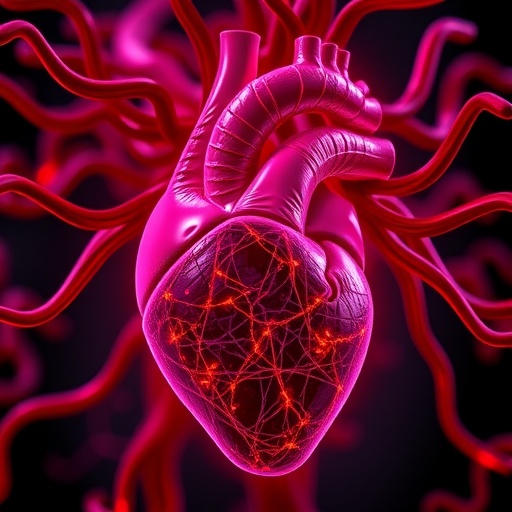
In a groundbreaking study poised to reshape therapeutic approaches to cardiac injury, researchers have unveiled the molecular prowess of FL3, a compound that significantly mitigates damage caused by cardiac ischemia-reperfusion injury (IRI). This type of injury occurs when blood supply returns to the heart after a period of ischemia or lack of oxygen, paradoxically leading to further cellular damage rather than recovery. The new findings illuminate how FL3 exerts protective effects by promoting mitochondrial fusion, a critical process in maintaining intracellular calcium homeostasis and, consequently, cardiac cell survival.
Cardiac ischemia-reperfusion injury remains a formidable challenge in clinical cardiology, frequently complicating the outcomes of heart attacks and surgical interventions such as coronary bypass grafting. The sudden restoration of blood flow induces oxidative stress and calcium overload within heart cells, triggering a cascade of destructive molecular events. These events culminate in cell death pathways, inflammation, and ultimately impaired cardiac function. Researchers have long sought interventions that could moderate this reperfusion injury, thereby improving the prognosis and long-term health of patients with ischemic heart disease.
Mitochondria, often described as cellular powerhouses, play a pivotal role in cardiac cell viability, not only by generating ATP but also by regulating calcium dynamics and apoptotic signals. Under stress conditions like IRI, mitochondria undergo morphological changes, including fragmentation or fusion, which directly influence their function. Mitochondrial fusion is particularly important during stress responses, as it helps dilute damaged mitochondrial components, preserve mitochondrial DNA integrity, and stabilize energy production. However, pathological conditions frequently disrupt this delicate balance, leading to mitochondrial fragmentation that exacerbates cell injury.
.adsslot_rUyKbHp4nj{width:728px !important;height:90px !important;}
@media(max-width:1199px){ .adsslot_rUyKbHp4nj{width:468px !important;height:60px !important;}
}
@media(max-width:767px){ .adsslot_rUyKbHp4nj{width:320px !important;height:50px !important;}
}
ADVERTISEMENT
The team led by Zhong, Z., Hou, Y., Zhou, C., and colleagues focused their investigation on FL3, a small molecule previously noted for its cytoprotective effects in other contexts. They discovered that FL3 facilitates mitochondrial fusion by modulating key proteins involved in the fusion machinery. This restoration of mitochondrial network integrity was found to be crucial in re-establishing calcium homeostasis within cardiomyocytes—heart muscle cells that are profoundly affected during IRI.
Calcium ions serve as fundamental signaling molecules in cardiac physiology, regulating contraction and energy production. In reperfusion injury, dysregulated calcium influx derails normal cellular processes, provoking mitochondrial calcium overload that precipitates mitochondrial permeability transition pore opening and cell death. By promoting mitochondrial fusion, FL3 helps modulate mitochondrial calcium uptake and buffering, thereby protecting the cellular milieu from toxic calcium spikes.
Molecular analyses revealed that FL3 upregulates mitofusins—specifically MFN1 and MFN2—which are essential mediators of outer mitochondrial membrane fusion. This upregulation leads to the reestablishment of interconnected mitochondrial networks, supporting more efficient calcium handling and mitochondrial respiration. The researchers demonstrated that, in the presence of FL3, mitochondria displayed elongated and tubular morphologies as opposed to the fragmented profiles typically seen following ischemia-reperfusion.
The functional consequences of FL3-mediated mitochondrial fusion were examined using both in vitro cardiomyocyte models and in vivo rodent models of cardiac ischemia-reperfusion. Treated specimens showed marked improvements in cardiac contractility and reduction in infarct size, underscoring the translational potential of FL3 as a cardioprotective agent. These observations were bolstered by measurements of mitochondrial membrane potential, reactive oxygen species production, and apoptotic markers, all of which indicated a reversal of the deleterious reperfusion-induced changes.
Importantly, this study also delved into the signaling pathways downstream of FL3 treatment, uncovering modulation of calcium-sensitive enzymes such as calcineurin and calmodulin-dependent kinases. These signaling molecules are integrally involved in translating calcium fluctuations into gene expression changes and cellular responses. By restoring calcium equilibrium, FL3 indirectly maintains the fidelity of these pathways, thus ensuring cellular homeostasis and survival.
The broader implications of these findings suggest that targeting mitochondrial dynamics represents a promising avenue in the battle against ischemic heart disease and reperfusion injury. Unlike therapies that merely attempt to scavenge reactive oxygen species or block calcium channels, FL3’s ability to reinforce mitochondrial architecture addresses the root cause of mitochondrial dysfunction. This paradigm shift may inspire novel drug designs focused on enhancing mitochondrial resilience.
Moreover, the research team highlighted that FL3 treatment did not exhibit evident cytotoxicity nor adverse effects on cellular metabolism in their experimental models, an encouraging sign for future clinical trial considerations. As mitochondria are essential not only in the heart but in various tissues prone to ischemic injury, FL3 or similar compounds could find applications across a spectrum of medical conditions involving reperfusion injury.
This study also contributes to a growing body of literature emphasizing the dynamic nature of mitochondria and their critical role beyond energy metabolism. The intricate balance of mitochondrial fission and fusion emerges as a frontline defense mechanism against cellular stress, and pharmacologically harnessing this balance is rapidly gaining traction as a therapeutic strategy.
In conclusion, the revelations surrounding FL3’s role in mitigating cardiac ischemia-reperfusion injury by promoting mitochondrial fusion illuminate a novel therapeutic target with profound clinical potential. By restoring calcium homeostasis and mitochondrial integrity, FL3 safeguards cardiac cells from the fatal consequences of reperfusion-induced calcium dysregulation. These insights not only advance our understanding of cardiac pathophysiology but also promise a future where mitochondrial dynamics-directed therapies become standard care for ischemic heart disease patients.
As the scientific community moves forward, further clinical investigations and development of FL3 analogs will likely accelerate, bringing hope to millions affected by coronary pathology. This pioneering work sets a foundational precedent for an era where tuning mitochondrial morphology becomes central to cardioprotection and broader ischemia management strategies.
Subject of Research: Cardiac ischemia-reperfusion injury and mitochondrial dynamics in cardiomyocytes
Article Title: FL3 mitigates cardiac ischemia-reperfusion injury by promoting mitochondrial fusion to restore calcium homeostasis
Article References: Zhong, Z., Hou, Y., Zhou, C. et al. FL3 mitigates cardiac ischemia-reperfusion injury by promoting mitochondrial fusion to restore calcium homeostasis. Cell Death Discov. 11, 304 (2025). https://doi.org/10.1038/s41420-025-02575-w
Image Credits: AI Generated
DOI: https://doi.org/10.1038/s41420-025-02575-w
Tags: calcium homeostasis in heart functioncardiac cell survival strategiesFL3 compound cardiac protectionimproving prognosis in heart attack patientsinnovative treatments for cardiac ischemiainterventions for ischemic heart diseaseischemia-reperfusion injury preventionmitochondrial dynamics and cardiac viabilitymitochondrial fusion in heart cellsoxidative stress in cardiac healthrestoring blood flow effects on the hearttherapeutic approaches for heart injury





